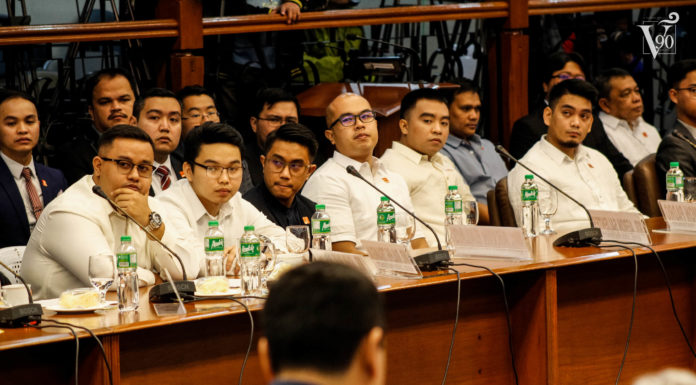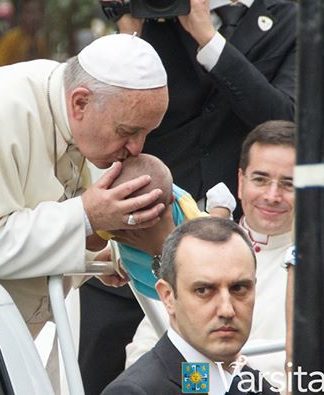The Varsitarian looks back to the events that have cast a pall on the future of ROTC.
16 December 1999
The Varsitarian publishes a Special Reports article titled “In the Line of Fire,” which details anomalies and irregularities in the ROTC.
December 2000
Faculty of Engineering sophomores Mark Welson Chua and Romulo Yumul file a complaint with the Department of National Defense (DND), alleging corruption in the UST-ROTC, which is supported by complaints of other basic cadets. The complaint is given due course by the National Capital Region-Regional Community Defense Group (NCR-RCDG).
9 January 2001
Mark Chua and Romulo Yumul go to the Varsitarian office to submit a copy of their complaint. They accuse the UST ROTC Department of widespread corruption, extortion, and other irregularities, including hazing.
16 January
After a series of investigations by the DND and the NCR-RCDG, UST-ROTC Commandant Major Demy Tejares is relieved of his office, together with his entire staff, by Group Commander Colonel Froilan Maglaya, due to command responsibility.
28 January
Captain Rodolfo Batang formally assumes the post left by Tejares.
21 February
The Varsitarian publishes another special report on the anomalies in the UST-ROTC titled “Struggle Against the System,” citing Chua and Yumul’s formal complaint and the relief of the UST DMST Command and Staff.
15 March
At around, 4 p.m. Welson Chua calls his son on his cellphone to ask him about the recordable compact discs he asked him to buy at Raon St. Welson asks his son what time he will come home and the younger Chua says he will be home by 8 p.m.
At 10 p.m., Welson Chua and his brother eat at Hossein’s Kebab in Makati Avenue. Chua’s brother texts Mark to follow them at the restaurant and gives directions. In reply, Mark texts back “m on my way dad.”
16 March
An hour and a half after midnight, Chua and his brother start looking for Mark. They go to the UST Roque Ruaño Bldg. near the Engineerig Complex to check him.
Afterward they go home and Welson Chua calls Mark’s friends to ask his whereabouts.
At around 4 a.m., Welson Chua’s cell phone rings and his son’s number registers. On the other line, an adult says in Tagalog, “Nasa amin na ang anak mo, huwag kang maingay sa mga pulis, bibigyan kita hanggang bukas (at) maghanda ka ng P3 M kung gusto mong makita pa nang buhay ang anak mo.”
A call is again made later asking for the ransom money, but Welson Chua refuses to give it. The caller replies, “No money, no son.” Welson does not hear from the kidnappers again.
18 March
The Philippine Daily Inquirer (PDI) Metro section reports that the decomposing body of a man wrapped in a big red carpet was found floating at the Pasig River near Jones Bridge at the back of the Central Post Office Building. The body’s head reportedly was wrapped with a silver packaging tape, its hands tied with shoestring while its legs bound by a packaging tape.
Police described the unidentified body as a man in his 40s because of its advanced stage of decomposition.
20 March
Welson Chua and his former wife, Mark’s mother, go to the Presidential Anti-Organized Crime Task Force to report Mark’s kidnapping.
A few hours after, the decomposing body is confirmed to be Mark Chua’s body by his mother and stepfather, through his belongings and a dog tag with the word Chua inscribed on it.
21 March
A second autopsy of Mark’s body is conducted by Dr. Bernales of the NBI through the request of his family. The Chua family was not satisfied by the result of the first autopsy the WPD and the Tres Amigos Funeral Parlor.
22 March
The body is brought to the Arlington Funeral Homes.
24 March
Police investigators ascertain that Mark Chua did not die in the hands of a kidnap-for-ransom-gang.
His family and friends, including Yumul, say that Mark’s death was related to the anomalies he exposed at UST’s ROTC.
25 March
Mark Chua’s body is buried at the Everest Memorial Park in Susana Heights, Cavite after a long procession from Arlington in Sta. Mesa.
17 April
An AFP intelligence report states that Mark’s killers were the ones who abducted him. The report also says that Chua’s supposed kidnappers meant to kill him, but made it appear that they abducted him for ransom.
23 April
President Arroyo orders a speedy investigation on the murder of Mark Chua. She asks Department of Interior and Local Government Secretary to assist in the investigations.
25 April
Two witnesses surface, claiming that they saw four men dumped Mark Chua’s body in the Pasig River. Rico Hernandez Nicolan and Jeffrey Lucena identify Genesis and Jeffrey Binagatan as the suspects in a sworn statement.
Following the identification of the two suspects by the two witnesses, the NBI and the Western Police District arrest the Binagatan brothers, Genesis and Jeffrey.
30 April
Armed Forces of the Philippines Chief of Staff General Diomedio Villanueva and Department of Education, Culture, and Sports Secretary Raul S. Roco vow to work for the immediate abolition of the ROTC. Roco proposes the elimination of the ROTC in the college curriculum.
3 May
The Varsitarian publishes a Special Reports article titled “Final Salute,” a call for justice for Mark Chua.
7 May
Relatives of Mark Chua claim that they are being watched by suspicious men on board cars just across their residence at LPL Mansions in Makati City. They appealed to authorities to give them security.
25 May
UST leads seven other University Belt schools in calling for the abolition of the ROTC in a statement titled “The ROTC: Excising a Cancer.” According to the consortium, to allow the ROTC to continue would be “ultimately self-destructive.”
13 June
UST awards Mark the San Lorenzo Ruiz Medal of Courage, for “showing exceptional and exemplary courage in standing up for the truth and Thomasian ideals.”
24 June
Thomasian student activist groups lead a national day of protest against the ROTC. Hundreds of Thomasian cadets join the protest, chanting “Thomasian cadets no more.” The walkout suspends the training.
25 June
Armed Forces Chief of Staff Gen. Diomedio Villanueva confers posthumously on Mark Chua the Outstanding Achievement Medal, the highest award given by the Armed Forces on a civilian. The award recognizes Mark’s public service as cadet sergeant major of the UST Golden Corps of cadets and as a member of the School Intelligence Network of the ROTC where he performed “with dedication and commitment, and at times, without regard to his personal safety.”
1 July
Other Universities such as the University of the Philippines (Diliman), Polytechnic University of the Philippines, Far Eastern University, University of the East, and Centro Escolar University join the second mass walkout organized by student activists against the ROTC.
Meanwhile, in UST, cadets stage another boycott. The demonstrators burn the ROTC uniform as a sign of protest.
8 July
Cadets are segregated in morning and afternoon sessions. MS-11 classes are held in the morning, while MS-21 classes are held in the afternoon. By doing this, DMST officials hope to avert another boycott.
22 July
Members of ABOLISH!, a student network calling for the abolition of the ROTC, and hundreds of student cadets, hold a march on¯España St., Quezon Memorial Circle, and Monumento.
23 July
During the 12th Congress, two bills are introduced concerning ROTC. Rep. Plaridel Abaya introduces a bill seeking to establish the National Service Training Program (NSTP) while Bayan Muna Rep. Liza Masa introduces a bill seeking the creation of the Social Action Program (SAP) and the abolition of the ROTC.
NSTP shall have three components required for graduation: Military Service Training, Civic Welfare Service Training and Law Enforcement Service Training. SAP, on the other hand, will be optional, with activities that include advocacy program, anti-drug abuse campaigns, community immersion, ecological services, human rights education, informal literacy programs, medical training, and rescue and relief operations.
30 June
Sen. Loren Legarda, files a bill providing for a citizen’s ecology service course to replace Commonwealth Act I, which is the original law upholding compulsory ROTC.
2 September
The Senate Committee on National Defense headed by Sen. Rodolfo Biazon summons former UST-ROTC Commandant Major Demy Tejares in connection with the Mark Chua slay case. Tejares’s promotion to colonel is recalled.
4 September
Arroyo approves Department of National Defense Secretary Angelo Reyes’s recommendation to let the students select between civic welfare service or law enforcement service in place of military training.
5 October
The NBI identifies four new suspects on Chua’s murder. They are Michael Von Rainard Manangbao, Eduardo Tabrilla, Paul Joseph Tan, and Patrick Christopher Cruz. All four are cadet officers of the Philippine Army’s reserve command assigned to UST’s ROTC office at the time Chua was killed.
6 November
The Senate Committee on Education chair Sen. Renato Cayetano assures male college students that the bill making the ROTC optional will be approved no later than this month. Under this proposed law, students may get involved in implementing livelihood projects, work as interns in government offices, and perform community services. Those in their first or second years in college right now can wait until next school year to enjoy these alternative courses.
8 November
A new witness surfaces in the Department of Justice. The witness, a 20-year-old Fine Arts student and a UST ROTC officer from December 2000 to March 2001, declares in an affidavit before state prosecutor Aristotle M. Reyes that some officials and officers of the UST ROTC could be behind Chua’s death. He claims that he saw Chua at the DMST office on the night Chua disappeared.
According to the victim’s father, Welson, this new witness saw a man with his hands and feet tied and his head wrapped with packaging tape in the DMST office, which was the same manner Chua was fished out of the Pasig River.














